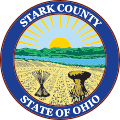2010 census
As of the 2010 census, there were 375,586 people, 151,089 households, and 100,417 families living in the county. [21] The population density was 652.9 inhabitants per square mile (252.1/km2). There were 165,215 housing units at an average density of 287.2 units per square mile (110.9 units/km2). [22] The racial makeup of the county was 88.7% white, 7.6% black or African American, 0.7% Asian, 0.3% American Indian, 0.5% from other races, and 2.2% from two or more races. Those of Hispanic or Latino origin made up 1.6% of the population. [21] In terms of ancestry, 33.6% were German, 15.5% were Irish, 10.1% were English, 10.1% were Italian, and 7.7% were American. [23]
Of the 151,089 households, 30.2% had children under the age of 18 living with them, 49.2% were married couples living together, 12.7% had a female householder with no husband present, 33.5% were non-families, and 28.1% of all households were made up of individuals. The average household size was 2.42 and the average family size was 2.96. The median age was 41.1 years. [21]
The median income for a household in the county was $44,941 and the median income for a family was $55,976. Males had a median income of $44,238 versus $31,896 for females. The per capita income for the county was $24,015. About 9.5% of families and 12.7% of the population were below the poverty line, including 19.5% of those under age 18 and 6.7% of those age 65 or over. [24]
2000 census
As of the census [25] of 2000, there were 378,098 people, 148,316 households, and 102,782 families living in the county. The population density was 656 inhabitants per square mile (253/km2). There were 157,024 housing units at an average density of 272 units per square mile (105 units/km2). The racial makeup of the county was 90.28% white, 7.20% black or African American, 0.24% Native American, 0.54% Asian, 0.02% Pacific Islander, 0.29% from other races, and 1.43% from two or more races. 0.92% of the population were Hispanic or Latino of any race.
There were 148,316 households, out of which 31.00% had children under the age of 18 living with them, 54.20% were married couples living together, 11.50% had a female householder with no husband present, and 30.70% were non-families. 26.10% of all households were made up of individuals, and 10.90% had someone living alone who was 65 years of age or older. The average household size was 2.49 and the average family size was 3.00.
In the county, the population was spread out, with 24.80% under the age of 18, 8.30% from 18 to 24, 27.80% from 25 to 44, 24.00% from 45 to 64, and 15.10% who were 65 years of age or older. The median age was 38 years. For every 100 females there were 92.40 males. For every 100 females age 18 and over, there were 88.40 males.
The median income for a household in the county was $39,824, and the median income for a family was $47,747. Males had a median income of $37,065 versus $23,875 for females. The per capita income for the county was $20,417. About 6.80% of families and 9.20% of the population were below the poverty line, including 12.90% of those under age 18 and 6.60% of those age 65 or over.






